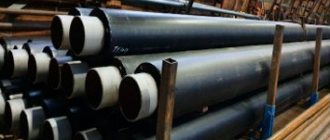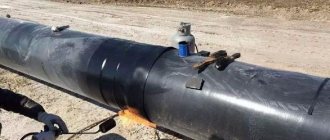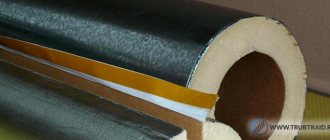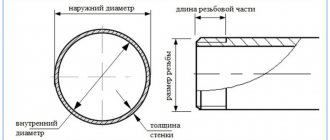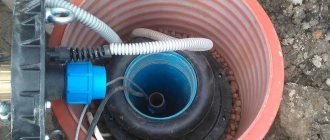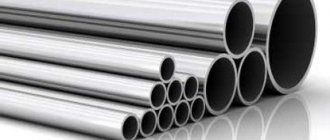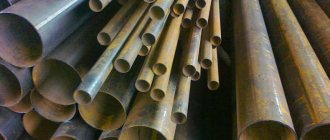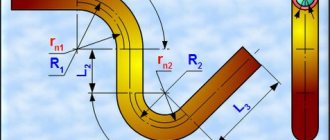Among all materials for thermal insulation, foamed plastics (foams) are the most popular in everyday life and in industry. One of their varieties is polyurethane types, used in industry and utilities as polyurethane foam insulation for pipes.
The use of ready-made factory pipes with thermal insulation allows you to save time and money when installing pipelines and significantly reduce heat losses during the operation of heating and plumbing systems, saving significant money. When laying pipelines from insulated pipes, welding and special laying technology are used using insulating segments at the joints and turns of the pipeline.
Fig.1 Appearance of products with PPU insulation
What are PPU pipes?
Standard pipes with polyurethane foam (PUF) insulation have a two-layer coating consisting of a foam insulator with an air content of about 98% and an outer durable polyethylene (HDPE) shell as protection. Sometimes the production technology provides for a three-layer coating of two HDPE shells, between which a polyurethane foam insulator is located.
The industry produces insulated pipes placed in a different type of outer shell - galvanized insulating steel, which allows for higher coating strength. Some galvanized and polyethylene shells are additionally equipped with stiffeners, which further increase their strength. In the marking for shells, an additional designation is introduced - PE for polyethylene and OC for galvanization.
In critical highways, pipes with a built-in electrical cable of the control system (SDC) are used, which performs the functions of an indicator diagnostic conductor. This allows you to monitor the integrity of the line along its entire length and easily find problem areas during equipment operation.
Fig.2 Pipes in polyurethane foam - device
Pipes in polyurethane foam - areas of use and technical characteristics
GOST 30732-2006 regulates the technical conditions for pipes with polyurethane foam insulation and specifies their scope of application in the following conditions:
- Pipes in a PE shell are designed for underground installation of heating networks using a ductless method (lowering into earthen trenches).
- Pipes in a protective metal sheath are designed for installation in passageways, tunnels and on the ground surface.
- The operating pressure in the system should not exceed 16 bar.
- The carrier temperature is up to +140º C, or +150º C when used in highways with its values ranging from +70 to +150 C.
It is allowed to use pipelines for water supply and sewerage, oil and gas supply, in industrial engineering networks when moving liquids from tanks, large containers and storage facilities.
Rice. 3 Polyurethane foam pipe insulation - parameters
Related article:
VGP pipe - dimensions, release forms, features of the threaded connection . On our website there is a separate article devoted to a review of VGP water and gas pipes, assortment, connection options, installation.
For above ground installation
| Pipe diameter, mm | Shell diameter mm (galvanized) | Pipe insulation services rub/m | PPU outlet OC rub/piece | Fixed supports PPU OTs rub/pcs. | Quantity |
| 25x3.2 For above-ground installation | 100 | 414 | 1090 | 4005 | |
| 32x3.2 For above-ground installation | 100 | 441 | 1090 | 4005 | |
| 40x3.5 For above-ground installation | 125 | 560 | 1260 | 4005 | |
| 57x3.5 For above-ground installation | 140 | 618 | 1660 | 4880 | |
| 76x3.5 For above-ground installation | 160 | 710 | 1920 | 5470 | |
| 89x3.5 For above-ground installation | 180 | 810 | 2200 | 5870 | |
| 108x4.0 For above-ground installation | 200 | 859 | 3030 | 6070 | |
| 133x4.5 For above-ground installation | 225 | 952 | 4140 | 9200 | |
| 159x4.5 For above-ground installation | 250 | 1110 | 4810 | 10450 | |
| 219x6.0 For above-ground installation | 315 | 1547 | 7820 | 17980 | |
| 273x6.0 For above-ground installation | 400 | 2110 | 11510 | 27480 | |
| 325x7.0 For above-ground installation | 450 | 2749 | 13860 | 40610 | |
| 426x7.0 For above-ground installation | 560 | 3698 | 32620 | 47870 | |
| 530x8.0 For above-ground installation | 710 | 5841 | 51090 | 67090 |
PPU insulation for pipes - pros and cons
The high performance properties of pipes in polyurethane foam insulation are due to the production technology, which includes the following stages:
- The outer polyethylene shell is produced by extrusion. To do this, polyethylene is squeezed out of a special mold, which hardens to a solid state.
- A steel pipe is inserted into the outer HDPE shell on spacers and copper cables are placed.
- Molten polyurethane foam is fed into the space between the walls of the steel and plastic outer pipe, which, after hardening, forms the finished product.
Advantages of PPU thermal insulation
Polyurethane foam insulation on pipes and their use has the following advantages over other technologies:
- In everyday life, polyurethane foam rubber is widely used as insulation; foam material, its solid counterpart, belongs to the class of foam plastics - materials that have air cells in their structure.
- High-quality factory production of products allows pipelines to be lowered directly into the ground, under water, without additional devices.
- Among its analogues - polyvinyl chloride, phenol-formaldehyde, urea-formaldehyde and polystyrene foams, polyurethane foam has the lowest thermal conductivity (0.02 W/m*K) - almost two times less than that of polystyrene foam.
- When installing a pipeline with ready-made thermal insulation, the speed of work increases significantly; enterprises manufacture ready-made shaped products in thermal insulation (tees, bends, transitions, branches) to simplify installation.
Why may the delivery length of pipes be slightly shorter or longer than ordered?
When issuing an invoice, the theoretical length of the pipe is taken. At metal warehouses, pipes are stored in bundles, and it is not possible to keep track of which pipe is on top and which is on the bottom. After paying the invoice, at the time of loading the steel pipe at the metal depot, the customer is informed how many strands of pipe and what length were loaded for it and clarifies: should the footage be rounded down or up?
When ordering a seamless pipe, everything is even more complicated; according to GOST 8732-78 and GOST 8734-78 it is unmeasured, that is, each rod has an individual length. GOST allows a difference from 4m to 12m. In reality, the difference in a particular batch is smaller, for example, from 9m to 11m. In some cases, when ordering a standard size, the insulation plant may cut it to size and keep the rest of the pipe, but such cases are always agreed upon in advance (before paying the invoice).
PPU insulation for shell pipes
In addition to factory-made steel pipes insulated with polyurethane, the construction market offers a wide range of shell insulation, mounted on pipelines of suitable diameters made of various materials and widely used in everyday life.
PPU shell insulation has the following parameters:
- The operating temperature range of the material used is from -190 to +150 C.
- The material is water-repellent, does not absorb moisture, its water absorption is less than 2%.
- The shell is light weight and is simply mounted by joining two segments into grooves; if necessary, the damaged area can be easily replaced, and the entire insulation can be reused after dismantling.
- The material is not susceptible to biological effects (mold, mildew), does not rot, and its service life is about 30 years.
- Polyurethane foam is inert to most chemicals and resistant to their effects.
- The shell is strong, hard varieties have a density of 40 to 60 kg. /m. cube
- The outer shell can be made of paper, fiberglass, foil, galvanized steel and other materials.
Rice. 7 Pipe in shell insulation
Configuration
Polyurethane foam shells are produced not only at industrial enterprises, but also in a semi-handicraft way at a number of small private industries thanks to simple technology. During manufacturing, a two-component composition is poured into the mold, the parts of which are Polyisocyanate and Izolan, and after hardening, the finished product is obtained.
The standard form of the products is a shell of two component cylindrical parts 1 meter long, which is mounted with a conventional connection and fixed using adhesives, adhesive tapes, polyurethane foam, clamps and ties. For large pipe diameters, the number of segments in the shells can be up to four.
Calculation of thermal insulation of pipelines
Calculation of the quantity (mass) of raw materials for production
It’s easy to calculate the density of any product by knowing the p(density) of the final product (according to regulatory documents) and calculating the volume V of the finished product.
m=pxV
Volume 1 l.m. thermal insulation PN x (Rinternal 2 – Rinternal 2)
Let's calculate the volume of the “shell” at ∅ 114 mm. with a thermal insulation thickness of 20 mm: P = 3.14 N = 1 m Rin. = 0.006 m3 Rin. = 0.003 m3
3.14*1*(0.006–0.003)= 0.009m3
Find the weight of the “shell.” The volume of the “shell” (cylinder) is multiplied by the density of the polyurethane foam. Let's assume the density of polyurethane foam is 60 kg/m3
0.009*60=0.551 kg.
In practice, as a rule, at least 10% is added to the mass, therefore, the calculated mass of the product is 0.606 kg - 606 g
We find the cost of the “shell.” We multiply the weight of the “shell” by the cost of 1 kg. systems.
Cost 1 kg. system is 152 rubles.
0.606*152=92 rub. 11kop.
Now we need to calculate the filling time.
Let the total productivity of the installation be 2.5/min, i.e. 2500 g/in 60 sec.
Let's make the proportion 2500/60 = 606/x, hence x =606•60/7000=14.54 seconds.
PPU shell coating
In the production of insulation shells, various methods are used to protect and strengthen its outer shell from physical and natural influences - this expands the scope of use of the material for domestic and industrial needs.
Without cladding
Sheath without lining is a budget option and is used for laying pipelines indoors without access to sunlight; sometimes it is wrapped with light-protective material or painted with thick, opaque paint.
Lining made of kraft paper or glassine
This cladding option is convenient because it allows you to save money on painting or protecting the shell from ultraviolet radiation in the uncladding version; the shell has an aesthetic appearance and does not require further processing. Mainly used in conditions where there are no mechanical loads on the surface - on highways inside industrial premises.
Fig.8 Heat-insulating shell coated with fiberglass, foil, galvanized, glassine
Fiberglass cladding
Products in a fiberglass shell are mainly used on external and underground pipelines - fiberglass is sufficiently resistant to large depths and mechanical loads. The fiberglass used reliably protects the product from ultraviolet radiation and chemical influences of the environment.
The requirements for sprayed surfaces are as follows:
- The surface must be dry, clean, not oily, without traces of active corrosion and must be warm (temperature not lower than +10– +15 degrees Celsius).
Therefore, when working on cryogenic pipelines, they are first turned off and allowed to warm up and dry.
- Work in winter on existing hot water supply pipelines is not fundamentally different from work carried out in the warm season, with the only difference being that consumable components need to be warmed up to operating temperature.
In the case of a heated sprayed surface, the ambient temperature is not of fundamental importance. Work on cold surfaces leads to deterioration of the adhesion of polyurethane foam to the pipe and radical overexpenditure of components.
PPU shell dimensions
The dimensional parameters of polyurethane shells must be combined with the diameter of the pipelines for which they are intended to insulate; in some cases, multilayer insulation is also produced - this requires matching the outer and inner diameters of shells of various sizes.
PPU shell internal diameter
The construction market offers products with an internal diameter from 57 to 1420 mm. (TU 5768-001-86901126-2011) from leading large Russian manufacturers with large production areas. Many handicraft enterprises produce their products with the most popular internal diameter sizes from 40 to 400 mm, satisfying the needs of most small consumers.
PPU shell thickness
The characteristics and dimensions of the shells are closely related to the dimensional parameters of the pipeline on which they are mounted - the larger the diameter, the higher the other dimensional parameters, usually the thickness varies from 20 to 100 mm.
Angle of contact of half-segments
The standard length of shells is 1 meter; with different diameters of pipelines, to facilitate installation and production, it is made from a different number of segments, the usual number of which does not exceed 4.
The corresponding contact angle for segments (radial angle) according to TU 5768-001-86901126-2011 is:
- 180 degrees for two elements, applies if the pipeline diameter does not exceed 530 mm.
- 120 degrees for 3 segments with external pipeline dimensions from 530 to 820 mm.
- 90 degrees with line diameters from 820 to 1420 mm.
Rice. 10 Pipes insulated with polyurethane foam and shell - marking
Related article:
Everything for thermal insulation of pipes - materials, application, installation technology . On our website there is a separate article describing in detail all types of thermal insulation materials used indoors or outdoors. Read it, it might be interesting.
Condition of heating networks in St. Petersburg
The heating network system of St. Petersburg is one of the most extensive in Russia. The total length of the pipelines exceeds 4770 km, and the diameter of the pipes varies from 50 to 1400 mm. Heating mains are mostly laid underground. Unfortunately, a significant part of them are in emergency or pre-emergency condition, since these are still Soviet pipes 30 years old. Therefore, the installation of new energy-efficient heating networks is more important than ever for the city.
The information in the article is current as of 06/01/2021.
Marking of industrial pipes with polyurethane insulation and shells
The designation of industrially produced products according to GOST 30732-2006 includes the symbols:
- The abbreviated name of the pipe material, usually steel with the designation St.
- Outer diameter (mm).
- Wall thickness (mm).
- For products with HDPE casing, insulation class (1 - normal, 2 - reinforced).
- The designation of the heat-insulating material is polyurethane foam.
- Marking of external protection (PE - polyethylene, OTs - galvanized steel)
- Reinforcement with bandages – B.
- Indication of the corresponding GOST 30732-2006.
The shell designation consists of the following symbols:
- Product name, shell – SK.
- Inner diameter (mm).
- Manufacturing material (PPU polyurethane foam).
- Thickness of the heat-insulating layer (mm.).
- Availability of a protective outer coating (PO).
Rice. 11 Examples of shell and pipe installation
For underground installation
| Diameter, mm | Shell diameter, mm | Insulation services rub/m | PPU PE outlet rub/piece | PPU PE bend shortened RUB/pcs | Non-supporting supports PPU PE rub/pc. | End elements PPU PE rub/piece | Quantity |
| 25x3.2 For underground installation | 110 | 407 | 1550 | 930 | 3454 | 4460 | |
| 32x3.2 For underground installation | 110 | 401 | 1630 | 981 | 3654 | 4534 | |
| 40x3.5 For underground installation | 110 | 444 | 1740 | 1042 | 4069 | 4628 | |
| 57x3.5 For underground installation | 125 | 419 | 2140 | 1240 | 4724 | 4983 | |
| 76x3.5 For underground installation | 140 | 495 | 2515 | 1548 | 5433 | 5522 | |
| 89x3.5 For underground installation | 160 | 591 | 2998 | 1841 | 5825 | 6822 | |
| 108x4.0 For underground installation | 180 | 663 | 3588 | 1884 | 6651 | 8587 | |
| 133x4.5 For underground installation | 225 | 960 | 5615 | 3781 | 8745 | 10650 | |
| 159x4.5 For underground installation | 250 | 1126 | 7273 | 5695 | 10731 | 11838 | |
| 219x6.0 For underground installation | 315 | 1576 | 13081 | 9483 | 18064 | 18814 | |
| 273x6.0 For underground installation | 400 | 2319 | 16267 | 14082 | 28357 | 23416 | |
| 325x7.0 For underground installation | 450 | 2925 | 24928 | 19644 | 41536 | 27879 | |
| 426x7.0 For underground installation | 560 | 3947 | 38720 | 28767 | 48342 | 39086 | |
| 530x8.0 For underground installation | 710 | 6159 | 57785 | 42760 | 69676 | 48312 | |
| * Delivery cost (Moscow to the Third Transport Ring): MAZ 12 m 20 tn - 9500 rubles, MAZ 6 m 10 tn - 8500 rubles. | |||||||
| We provide joint sealing services | |||||||
Work on installation of polyurethane foam shell
Laying pipes in a polyurethane foam shell with your own hands is not particularly difficult and is accessible to almost anyone - the segments are light in weight and 1 meter long.
For domestic use, shells and pipes of small diameter can be laid on the ground and lowered into a trench after connection; in the case of heavy main pipelines, installation is carried out directly in trenches or on the surface when located externally. A step-by-step method to insulate a pipeline with your own hands consists of several simple operations:
- A segment is placed on a section of the pipeline and connected to other parts using locks with a slight shift of 1/3 of the length.
- To secure the fragments, glue, adhesive tape, ties and clamps are used.
- Curvilinear sections of pipelines are insulated with segments that are cut from the shell or purchased together with the main components; they are also secured in offset grooves and secured with additional fasteners.
The production of pipes in polyurethane foam is the main method of insulating heat-conducting mains in the industrial and public sector due to the unique properties of the material - increased thermal protection of all insulators. In the domestic sphere, insulated polyurethane foam shells are used in the form of a shell - they are used in heating systems, hot and cold water supply and sewage systems (for protection against freezing).
How to install insulation
The installation method depends on the type and form of the insulation, the presence of a protective layer on it, and the need for its installation. If we are talking about fibrous roll or sheet materials, then the installation sequence should be as follows:
- pipes are cleaned of dirt and rust and dried;
- the insulation of the pipes is applied to them in turns with an overlap of several centimeters over the previous layer;
- each turn is secured with wire, twine or tape;
- if the material is without a protective layer, then foil insulation, roofing felt or other waterproof rolled material is wound over it in the same way, which is secured with tape glued along the joints.

